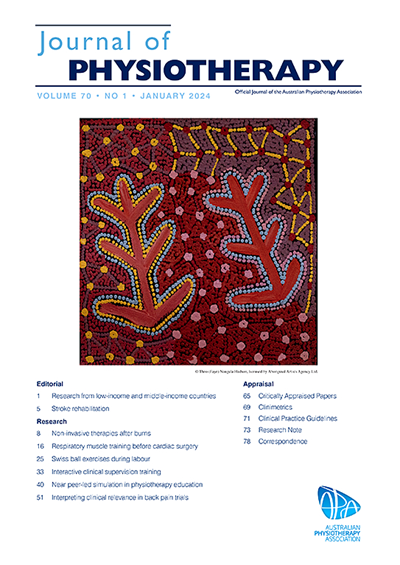Mechanically assisted walking with body weight support results in more independent walking and better walking ability compared with usual walking training in non-ambulatory adults early after stroke: a systematic review
IF 9.7
1区 医学
Q1 ORTHOPEDICS
引用次数: 0
Abstract
Questions
In subacute, non-ambulatory individuals after stroke, does mechanically assisted walking with body weight support result in more independent walking or better walking ability than usual walking training in the short term? Are any benefits maintained in the longer term? Is it detrimental to walking in terms of walking speed?
Design
A systematic review with meta-analysis of randomised studies with a Physiotherapy Evidence Database (PEDro) score > 4.
Participants
Non-ambulatory adults ≤ 12 weeks after stroke.
Intervention
Any type of mechanically assisted walking with body weight support.
Outcome measures
Independent walking (ie, proportion of independent walkers), walking ability (eg, 0 to 5 Functional Ambulation Category, FAC) and walking speed.
Results
Fifteen studies involving 1,014 participants (mean PEDro score 6.4) were included. In the short term, mechanically assisted walking with body weight support resulted in more independent walking (RD 0.19, 95% CI 0.11 to 0.26) and better walking ability (MD 0.8 on the FAC, 95% CI 0.5 to 1.0) compared with the same amount of usual walking training. In the longer term, it resulted in better walking ability (MD 0.6 on the FAC, 95% CI 0.2 to 1.1). Mechanically assisted walking with body weight support does not appear to be detrimental to walking speed in the short term (MD 0.13 m/s, 95% CI 0.03 to 0.22) or longer term (MD 0.11 m/s, 95% CI 0.00 to 0.22).
Conclusion
This review provides high-certainty evidence that mechanically assisted walking with body weight support results in more independent walking and better walking ability in individuals with stroke who are non-ambulatory subacutely compared with usual walking training. Given the importance of achieving walking in the short term, clinicians are encouraged to use this intervention.
Registration
PROSPERO CRD42024549678
一项系统综述:与常规步行训练相比,在中风后早期,机械辅助行走与体重支持可以使不能行走的成年人更独立行走和更好的行走能力。
问题:在亚急性,中风后不能走动的个体中,在体重支持下机械辅助行走是否能在短期内比常规行走训练更独立行走或更好的行走能力?是否有长期的好处?就步行速度而言,它对步行有害吗?设计:对物理治疗证据数据库(PEDro)评分为bbbb4的随机研究进行系统评价和荟萃分析。参与者:中风后≤12周不能活动的成年人。干预:任何类型的机械辅助行走与体重支持。结果测量:独立步行(即独立步行者的比例),步行能力(如0 - 5功能步行类别,FAC)和步行速度。结果:纳入15项研究,涉及1,014名受试者(平均PEDro评分6.4)。在短期内,与相同量的常规步行训练相比,机械辅助行走与体重支持导致更独立的行走(RD 0.19, 95% CI 0.11至0.26)和更好的行走能力(FAC的MD 0.8, 95% CI 0.5至1.0)。从长期来看,它导致更好的行走能力(FAC的MD为0.6,95% CI为0.2至1.1)。在短期内(MD为0.13 m/s, 95% CI为0.03 ~ 0.22)或长期(MD为0.11 m/s, 95% CI为0.00 ~ 0.22),机械辅助行走在体重支持下似乎不会对行走速度造成损害。结论:本综述提供了高确定性的证据,表明与常规步行训练相比,机械辅助行走与体重支持可以使非运动亚急性脑卒中患者更独立行走和更好的行走能力。鉴于短期内实现行走的重要性,鼓励临床医生使用这种干预措施。注册号:PROSPERO CRD42024549678。
本文章由计算机程序翻译,如有差异,请以英文原文为准。
求助全文
约1分钟内获得全文
求助全文
来源期刊

Journal of Physiotherapy
ORTHOPEDICS-REHABILITATION
CiteScore
11.40
自引率
7.40%
发文量
69
审稿时长
72 days
期刊介绍:
The Journal of Physiotherapy is the official journal of the Australian Physiotherapy Association. It aims to publish high-quality research with a significant impact on global physiotherapy practice. The journal's vision is to lead the field in supporting clinicians to access, understand, and implement research evidence that will enhance person-centred care. In January 2008, the Journal of Physiotherapy became the first physiotherapy journal to adhere to the ICMJE requirement of registering randomized trials with a recognized Trial Registry. The journal prioritizes systematic reviews, clinical trials, economic analyses, experimental studies, qualitative studies, epidemiological studies, and observational studies. In January 2014, it also became the first core physiotherapy/physical therapy journal to provide free access to editorials and peer-reviewed original research. The Australian Physiotherapy Association extended their support for excellence in physiotherapy practice by sponsoring open access publication of all Journal of Physiotherapy content in 2016. As a result, all past, present, and future journal articles are freely accessible, and there are no author fees for publication.
 求助内容:
求助内容: 应助结果提醒方式:
应助结果提醒方式:


